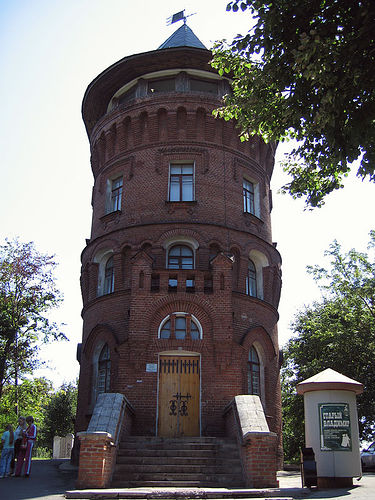

<>Constructed: late 19th century
Open: 10am- 5pm
Wed, Thu: 10am- 4pm
Closed: Mondays and last Thursday of a month
The water tower is a monument of industrial and
engineering architecture. The modern building of the water tower was
built in 1912. By the 1950s. the tower lost its functional
significance due to the reconstruction of Vladimir's water-pressure
system. Since 1975, an exposition called "Old Vladimir" has been
located in the water tower.
The need of the urban population
for a water tower appeared in the 1860s. when laying plumbing. Her
first project was to equip it in the inactive Rizpolozhenskaya
church above the Golden Gate. The city authorities approved the
project, but due to special circumstances (several workers were
covered with earth at the beginning of the work), they decided to
abandon such use of the church. It was decided, despite considerable
expense, to build a new building for the water tower. The tower was
erected to the south of the Golden Gate, on the Kozlov Val,
according to the project of K. Dill. Construction was completed in
1868 (possibly 1866). The tank of the tower contained 8 thousand
buckets of water. Simultaneously with the tower, several water
columns were built in different parts of the city, while in the
center, on Cathedral Square, a stone pool with a fountain and a
reservoir was installed. The water supply system was powered by a 25
hp steam engine brought from England. In 1912, the old water tower
was rebuilt according to the project of the Vladimir architect
Zharov S.M.
Now the building of the water tower is a
three-tiered building made of red brick, made in the
"pseudo-Russian" style and having the shape of a cistern in plan. At
the top, it is somewhat expanding, like a fortress tower. The
decoration of the tower are windows, including double ones, in each
tier of different heights, and rectangular "sandriks", and lancet
arches above the windows; cornice rollers that separate the tiers
and two belts of arched niches.
In the 1950s, in connection
with the reconstruction of the Vladimir water pipeline, the tower
was no longer used; for some time, vagrants gathered in the lower
floor.
In 1976, the tower was recognized as a monument of
urban planning and architecture, and in 1980 it was transferred to
the Vladimir-Suzdal Museum-Reserve. The tower was converted into a
museum of urban life by employees of the Vladimir restoration
workshop under the leadership of S. Yermolin - a spiral staircase
was built in the northern part; instead of a flat roof, they
arranged an observation deck with a tented completion. The southern
part of the building and the central "pockets" were reserved for the
exposition.
The author of the exposition, which is dedicated
to Vladimir of the late 19th - early 20th centuries. local historian
Leah Gorelik. The opening of the exposition took place in 1975. A
distinctive feature of this exposition is that it did not contain
special explanatory texts, but instead of them, genuine extracts
from newspapers, books, magazines of that time were given. The
exposition tells and shows Vladimir city life in its everyday,
everyday course, reconstructs the atmosphere of Vladimir at the turn
of the century - merchant, bureaucratic, petty-bourgeois. To
emphasize the era, the interiors of the church shop, the room of a
wealthy citizen, a tavern with a samovar, and a police station were
recreated.
In 2009, the museum was reconstructed, some of the
exhibits and exposition equipment were replaced here. The first
floor is dedicated to the appearance of Vladimir before the
revolution and his urban economy. Postcards and photographs of the
late 19th - early 20th centuries are exhibited here. streets,
ancient cathedrals, squares, churches, public buildings of the city,
documents of the city economy on the activities of the council, the
construction of the first and power plant, the fire brigade. The
clothes of Vladimir residents of different classes are exhibited
here.
The second floor tells about the urban population and
their occupations. On the stands are photographs of merchants,
nobles, burghers, clergy, raznochintsy officials of various
departments, the military. Here you can get acquainted with
documents about their traditional occupations: yam fishing,
gardening and horticulture. Among the exhibits of this hall are the
awards of gardeners of Vladimir, received by them at Russian
agricultural exhibitions, arched bells, driver's clocks. Bright
advertising of various trading companies, hotels, taverns,
restaurants, photo services, hairdressing salons attracts attention.
On the third floor, visitors get acquainted with the spiritual
life of the inhabitants of Vladimir. On the stands there are
photographs of monasteries, processions. Here are materials about
educational institutions of the city: women's and men's gymnasiums,
a real school, a theological seminary.
The fourth floor of
the museum is an observation deck, from where a colorful panorama of
the city and the Zaklyazma distances opens, where many architectural
monuments are concentrated.
The museum's exposition features
about 800 exhibits, more than 100 of them appeared for the first
time. Among the exhibits are interesting pieces of furniture, a
telephone, a baby stroller, a sewing machine, a film projector, a
dish - a gift to Nicholas II from the nobility of Vladimir, a silver
horn for babies, student supplies.
The bright imagery of the
museum exposition is given by photographs of large format with views
of the city, as well as mannequins in the clothes of those times.
The central showcases of all halls create a kind of vertical axis in
the solution of the exposition space.